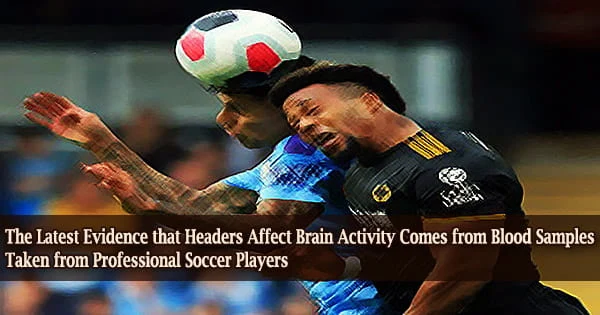The latest study to analyze the possible consequences of heading in soccer finds that repetitive headers and accidental head hit in soccer cause changes in blood patterns, which are linked to brain signaling pathways and potential modifications.
Experts analyzed blood samples from 89 professional soccer players in a variety of settings, including match play and training that included heading, in this first-of-its-kind new study. Aside from heading, they obtained samples from other high-intensity exercises.
The findings, which were published in the peer-reviewed journal Brain Injury, show “specific alterations” in the amounts of microRNAs in the brain, which are now recognized as blood biomarkers and are linked to signaling pathways that reflect brain modifications.
MicroRNAs (biomarkers) were identified to disrupt linkages to various signaling pathways involved in brain activity when experts looked into accidental head impacts specifically. Experts discovered dysregulation of other microRNAs connected to a different biological signaling pathway while examining heading. Importantly, alternative forms of high-intensity exercise had no effect on these microRNAs.
Stian Bahr Sandmo, of the Oslo Sports Trauma Research Center at the Norwegian School of Sport Sciences, who headed an international team of experts in the study, said the findings “contribute to our understanding of head hits in soccer.”
“This is a relatively small sample-size exploratory study,” he says, “but, future findings expanding upon our research could ultimately lead to an improved understanding of the potential hazardous effects of repetitive head impacts. With millions of people playing soccer worldwide, this might ultimately have a substantial influence on public health.”
MicroRNAs are small molecules that are found in human cells and circulate in bodily fluids such as blood (then referred to as “circulating microRNAs”). They aid in the regulation of gene expression, which is the process by which our DNA instructions are turned into a functioning output, such as a protein.
This is a relatively small sample-size exploratory study; but, future findings expanding upon our research could ultimately lead to an improved understanding of the potential hazardous effects of repetitive head impacts. With millions of people playing soccer worldwide, this might ultimately have a substantial influence on public health.
Stian Bahr Sandmo
They play a role in a variety of physiological functions. Previous research has suggested that mild traumatic brain injury (TBI) alters the expression of some microRNAs in the blood.
As a result, new research is being conducted, such as this one, to see how and whether microRNAs might be employed as brain damage indicators. The consequences of soccer-related head impacts on microRNAs have mainly remained unknown till now.
The goal of this new study was to see if these head impacts changed the amounts of microRNAs, indicating short-term consequences in the brain.
The outcomes were then compared to those of previous high-intensity workouts. Depending on the results, this could add to or subtract from the growing body of evidence supporting the use of microRNAs as biomarkers for brain injury.
At rest, blood samples were taken from 89 professional soccer players. The players were between the ages of 18 and 35 and competed in the Eliteserien (the Norwegian premier league). Repeat samples were drawn after one hour, and again at 12 hours, following three conditions:
- accidental head impacts in a match (any situation in which a player appears to have been struck in the head, face, or neck, the match has been stopped by the referee, and the player has been lying on the ground for more than 15 seconds)
- repetitive headers during training
- high-intensity exercise (because the effects of strenuous physical activity had to be taken into consideration, it was necessary to separate microRNAs unique to brain injury rather than those impacted by exercise).
The microRNAs that were discovered were then evaluated in order to find microRNAs that were consistently unregulated. Bioinformatics was also utilized to identify genes targeted by microRNAs and to characterize their functions in biological processes and signaling cascades.
When they looked at accidental head injuries, they discovered that eight microRNAs were deregulated, which were unaffected by high-intensity exercise; the target genes identified were linked to 12 signaling pathways, including the Wnt pathway, which may promote nerve cell regeneration following TBI, according to research. This includes Hedgehog signaling, which has been shown to prevent nerve cell mortality and damage following TBI in animal studies.
Six microRNAs were found to be altered by repetitive headers, which were linked to TGF-? signalling.
Previous research has reported elevated TGF-? levels in the fluid surrounding the brain have been found to be raised after a TBI, suggesting it may play a role in anti-inflammatory and neuroprotective signaling.
“Overall,” the expert team state, “the findings do add further evidence to demonstrate how microRNAs may be used as brain injury biomarkers. These have the potential to differentiate injury severity and to discriminate between types of head impacts seen in soccer if reproduced in further studies.”
The team was unable to quantify the biomechanical magnitudes of the impacts in the different conditions due to the small sample size and the fact that head-impact exposure was characterized using direct observation and video analysis, implying that the team was unable to quantify the biomechanical magnitudes of the impacts in the different conditions.





